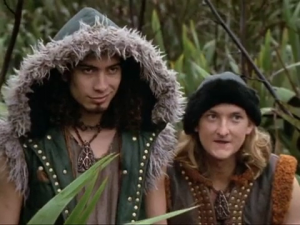Cratus: Difference between revisions
(Created page with 'right|thumb|300px| * '''Appeared in:''' 1.04 Herc and Seek * '''Played by:''' [http://www.imdb.com/name/nm1287538/ Toi Iti] Cratus is the leader of the ga…') |
No edit summary |
||
| (8 intermediate revisions by 3 users not shown) | |||
| Line 1: | Line 1: | ||
[[Image: | [[Image:Cratus 01.png|right|thumb|300px|]] | ||
* '''Appeared in:''' [[1.04 Herc and Seek]] | * '''Appeared in:''' [[1.04 - Herc and Seek]] | ||
* '''Played by:''' [ | * '''Played by:''' [[Toi Iti]] | ||
Cratus is the leader of the gang [[:Category:Lowacks|The Lowacks]]. | Cratus is the leader of the gang [[:Category:Lowacks|The Lowacks]]. | ||
[[Category:Canon]][[Category:Characters]][[Category:Lowacks]][[Category:Humans]] | * May or may not have been intended to be the same character as [[Cradus]]. | ||
Mythology | |||
Kratos or Cratos[a] is the divine personification of strength in Greek mythology. He is the son of Pallas and Styx; he and his siblings Nike ("Victory"), Bia ("Force"), and Zelus ("Zeal") are all essentially personifications.[5] Kratos is first mentioned alongside his siblings in Hesiod's Theogony. According to Hesiod, Kratos and his siblings dwell with Zeus because their mother Styx came to him first to request a position in his regime, so he honored her and her children with exalted positions. Kratos and his sister Bia are best known for their appearance in the opening scene of Aeschylus's Prometheus Bound. Acting as agents of Zeus, they lead the captive Titan Prometheus on stage. Kratos compels the mild-mannered blacksmith god Hephaestus to chain Prometheus to a rock as punishment for his theft of fire.[6] Kratos is characterized as brutal and merciless, repeatedly mocking both Hephaestus and Prometheus and advocating for the use of unnecessary violence. He defends Zeus's oppressive rule and predicts that Prometheus will never escape his bonds. In Aeschylus's Libation Bearers, Electra calls upon Kratos, Dike ("Justice"), and Zeus to aid her brother Orestes in avenging the murder of their father Agamemnon. Kratos and Bia appear in a late fifth-century BC red-figure Attic skyphos of the punishment of Ixion, possibly based on a scene from a lost tragedy by Euripides. They also appear in late eighteenth and nineteenth-century Romantic depictions and adaptations of the binding of Prometheus. | |||
[[Category:Canon]][[Category:Characters]][[Category:Lowacks]][[Category:Humans]][[Category:Villains]] | |||
Latest revision as of 21:43, 22 February 2019
- Appeared in: 1.04 - Herc and Seek
- Played by: Toi Iti
Cratus is the leader of the gang The Lowacks.
- May or may not have been intended to be the same character as Cradus.
Mythology Kratos or Cratos[a] is the divine personification of strength in Greek mythology. He is the son of Pallas and Styx; he and his siblings Nike ("Victory"), Bia ("Force"), and Zelus ("Zeal") are all essentially personifications.[5] Kratos is first mentioned alongside his siblings in Hesiod's Theogony. According to Hesiod, Kratos and his siblings dwell with Zeus because their mother Styx came to him first to request a position in his regime, so he honored her and her children with exalted positions. Kratos and his sister Bia are best known for their appearance in the opening scene of Aeschylus's Prometheus Bound. Acting as agents of Zeus, they lead the captive Titan Prometheus on stage. Kratos compels the mild-mannered blacksmith god Hephaestus to chain Prometheus to a rock as punishment for his theft of fire.[6] Kratos is characterized as brutal and merciless, repeatedly mocking both Hephaestus and Prometheus and advocating for the use of unnecessary violence. He defends Zeus's oppressive rule and predicts that Prometheus will never escape his bonds. In Aeschylus's Libation Bearers, Electra calls upon Kratos, Dike ("Justice"), and Zeus to aid her brother Orestes in avenging the murder of their father Agamemnon. Kratos and Bia appear in a late fifth-century BC red-figure Attic skyphos of the punishment of Ixion, possibly based on a scene from a lost tragedy by Euripides. They also appear in late eighteenth and nineteenth-century Romantic depictions and adaptations of the binding of Prometheus.
